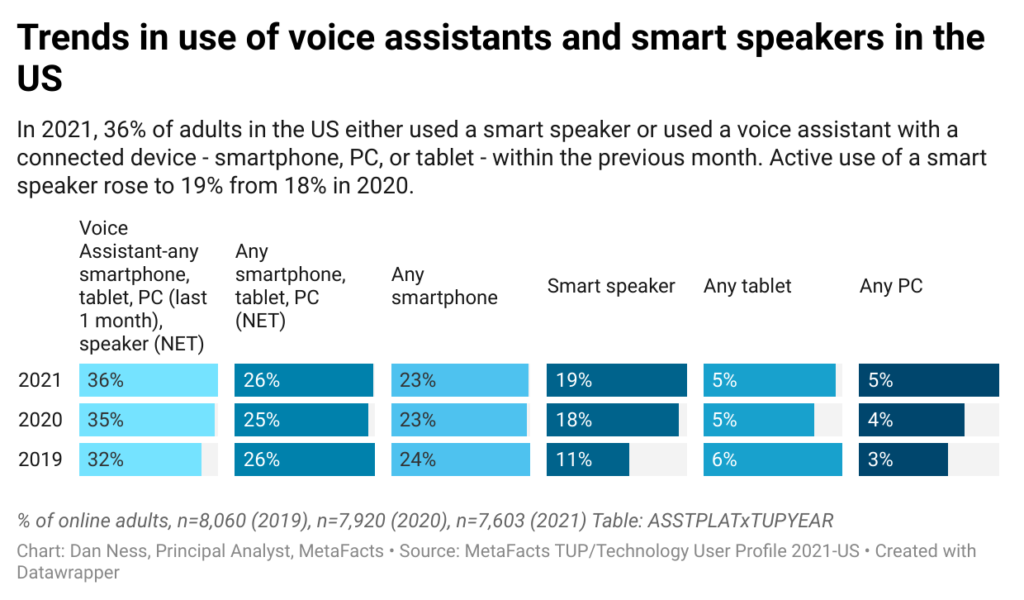How different are advantaged from disadvantaged Americans in how many devices they actively use? How much has this changed since before the pandemic? How do historically socioeconomically advantaged groups such as high-income or college graduates compare to disadvantaged groups such as single parents, low-income, less-educated, elderly, or people of color? This TUP analysis reports on the average number of connected devices – mobile phones, computers, tablets, and game consoles – being used by each socioeconomic group.
Technology profile of low-income Americans in large households
The COVID pandemic made clear many socioeconomic inequities between Americans, as the impact of the virus was felt differently in great part depending on their educational attainment, occupation, employment status, and other factors.
This TUPdate focuses on one segment – Americans in households with 4 or more persons and a household income of $35,000 or less – reporting their market size and profiling their usage of connected devices, which devices they do or don’t use, how much they use them, and the intensity of changes since before the pandemic.
Technology profile of American childless partnered employees aged 18-49
The COVID pandemic made clear many socioeconomic inequities between Americans, as the impact of the virus was felt differently in great part depending on their educational attainment, occupation, employment status, and other factors.
This TUPdate focuses on one segment – employed Americans aged 18 to 49 who have a married or unmarried partner and who do not have a child 17 or younger in their household – reporting their market size and profiling their usage of connected devices, which devices they do or don’t use, how much they use them, and the intensity of changes since before the pandemic.
Highlights: Devices
There has been a sea change in which connected devices people use as well as how they use them. This TUP Highlights report details the trends in device ownership, the shifts between technology ecosystems, and market penetration levels. It spells out the major activities for each type of device, and how usage has changed. Furthermore, it details how many employees use personal devices for remote work.
Technology profile of low income renters
During the pandemic, low-income American renters were a large segment of Americans strongly disrupted by shutdowns, work interruptions, and even evictions. This historically socioeconomically disadvantaged market segment has the potential to benefit from technology that can enable less dangerous occupations, although starting from lower-than-average market penetration levels. This MetaFacts TUPdate report details how far below average this segment is in their use of connected devices, which types of devices they are (and aren’t) using, and how often they’re using what they have. Furthermore, it quantifies how many online adults in this segment do (and don’t) work from home.
Smart speakers among young and old
How deeply have smart speakers penetrated technology users’ lives? From 2019 to 2021, has market penetration shifted very much? Which age group has adopted smart speakers more quickly and deeply than others? How different is this in the US than in the UK or Germany or Japan? This TUP analysis reports on the percentage of online adults that actively use a smart speaker.
Technology profile of Asian American college graduates
The COVID pandemic made clear many socioeconomic inequities between Americans, as the impact of the virus was felt differently in great part depending on their educational attainment, occupation, employment status, and other factors.
This TUPdate focuses on one segment – Americans aged 18 and older who have graduated college and identify as Asian – reporting their market size and profiling their usage of connected devices, which devices they do or don’t use, how much they use them, and the intensity of changes since before the pandemic.
Online banking among socioeconomic groups
Using smartphones, PCs, or other connected devices for online banking is widespread, but not ubiquitous. Fewer American adults with lower income or less educational attainment use online banking than those with higher income or technically savvy. This MetaFAQs reports on the active usage of online banking among socioeconomically disadvantaged and advantaged groups, each defined by a combination of household income, educational attainment, homeownership, ethnicity, age, employment status, racial/ethnic identity, and other factors.
Breadth of voice assistant usage
Dan Ness, Principal Analyst, MetaFacts, December 13, 2021
Actively using a voice assistant or smart speaker
- This analysis focuses on those people who are actively using a voice assistant or smart speaker
- Have used a connected device to use a voice assistant within the previous month
- Smartphone, PC, or tablet
- Have a smart speaker
- Have used a connected device to use a voice assistant within the previous month
- Base: all online adults
Active voice assistant usage by platform – US
- The overall use of a voice assistant or smart speaker has only slightly increased between 2019 and 2021
- Smart speaker usage has grown the most among American online adults, rising from 11% in 2019 to 19% in 2021
- Voice assistant usage with other connected devices has not changed markedly
- Voice assistant usage with a smartphone continues to outpace smart speaker use

Technology profile of upper-income (>$150k) white male Americans
During the pandemic, socioeconomically advantaged groups changed their collection and usage of technology devices differently than historically disadvantaged groups. White male upper-income Americans already had higher-than-average technology device penetration. However, they have also been the first to reduce usage between 2020 and 2021. This TUPdate reports on this group’s status and change in connected devices by type – PCs, home PCs, work PCs, smartphones, game consoles, tablets, and feature phones. It also reports their work-from-home status, hourly device usage, number of devices, and market size.

